I’d imagine my love of Everdell is somehow linked to my love of The Wind in the Willows. Kenneth Grahame’s woodland masterpiece is the epitome of Dulce Domum. He chronicles friendship, belonging, adventure, fear, and peace in a manner and form fit for a child yet challenging enough for adult consideration. Piper at the Gates of Dawn is, pound for pound, one of my favorite chapters ever written for its ability to chronicle something undeniably larger than life as we know it. When the dust settles on the book and Toad Hall is once again restored, I turn the final page knowing that life goes on for Rat, Mole, Toad, Badger, and the whole creaturely gang:
“After this climax, the four animals continued to lead their lives… in great joy and contentment, undisturbed by further risings or invasions.”
I get similar feelings—feelings of home and grandeur—on a lesser scale when I finish a game of Everdell. The work of city building finished, with every uncertainty laid to rest, nothing remains but to enjoy the splendid scene and leave the critters to their new home in relative peace.
James and Clarissa Wilson have been busy since the release of Everdell in 2018. I gather they’ve been busy much, much longer, but I’m happy to leave that in the realm of speculation. Five full-scale expansions have come to the market, as well as a substantial handful of smaller modular options, culminating in the multi-million dollar Kickstarter campaign that delivered the Complete Collection in one massive twenty-pound box this autumn. Toss in the surprise release of My Lil’ Everdell and you’ve got quite a full plate.
With an expansion stretching in each compass direction, it sure seems like we’re closing the book on Everdell (in terms of game production, anyway), and the critters are at home on many a kallax around the world—probably on top, though, because of the sheer size of the box. I suppose it’s time to start evaluating the full panoramic experience.
Because there are often multiple modules within each expansion, I’ve chosen to focus on each retail package in this ranking. Admittedly, this leaves a couple of the packages quite light on materials. But I wouldn’t limit the potential of any expansion based on size alone. I’ve based the decision on mechanical, narrative, and aesthetic considerations. I’ve included a word on my favorite components up front and a quick snapshot of my “go-to” configuration at the end.
A word on components
The wider world is a better place for the squishy berries. We all know this. Perhaps no other component best exemplifies the welcoming mirth of Everdell than the berry. Now that they have an official home in the Deluxe basket, I’m thrilled. In fact, all the game’s base resources in their vessels (including the pearls) look as if they’d been like that all along. I’m tickled over the finished production.
While I now own the wooden EverTree, and it is beautiful, I would hardly call it necessary. It is more of a conversation piece for the mantle than a practical component. Before we logged a half-dozen plays of the base game, we dispensed with the assembly of the tree. While the world stretches less into the third dimension without it, I cannot defend it as anything more than decoration for those playing on oversized tables.

I’m a stickerless meeple guy. I adore the bare critters for their simplicity and I cannot see myself ever adding the stickers. My fingers barely survived stickering the door tokens!
Finally, a word of praise for the board itself in all its unorthodox glory. No rectangles here, folks! I applaud the decision to use rounded edges, insets, and interesting contours. I think Everdell feels more like a world right out of the box because the board is so very strange. Even in its unusual dimensions, it is terribly efficient and a fit showcase for the game.
I could stay here for days, but I’m sure I’ll address the highs and lows of the bonus components within the various expansion materials. That being said, let’s begin.
#8 – Rugwort
In some ways, the Rugwort Pack hardly counts as an expansion. Partly I say this because Rugwort (along with Extra! Extra! and Legends) was available from the beginning in the Collector’s Edition. But if you happened upon the world by accident like me, you started with the retail edition and hunted to expand the world. I also say “hardly” an expansion because three cards that are worth a collective two points with a stack of rat meeples hardly amount to radical transformation. And yet, this little pack introduces a mechanical element that seldom rears its head across every product in the Everdell family: take-that.
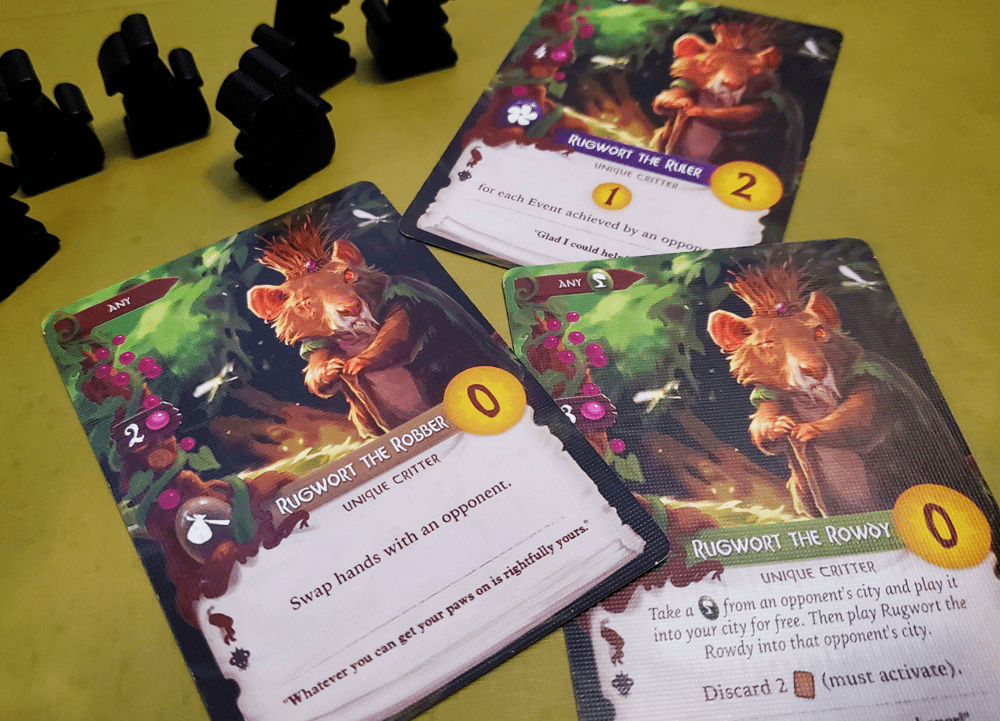
Rugwort is all about unleashing a bit of havoc—stealing cards, stealing hands, and hitching a ride on the accomplishments of others. The rat’s crusty personality is an anomaly in the wood, but his cards fit his ethos. The Rugwort solo mode in the base game glories in its propensity for punishment. I wouldn’t say I enjoy the cards, even though they are always in the base deck when we play. If we’re not in the mood for the rat—my daughter (my usual playing partner) typically is—we say so at the beginning and discard him when he appears. We’re happy to give him the dignity of saying hello in that way.
For an entirely different reason, I must express my gratitude for this little pack: the rat meeples are definitely in my top 3.
#7 – Bellfaire
My first play of Everdell lasted three hours. I was new to so many of the concepts in the base game that we were wide-eyed throughout the experience. Three of us played that first game. With Bellfaire, the invitation was set for up to six players. Six players! On the one hand, that’s so exciting. But on the other hand, every time a new player comes to the table, the length of the game jumps inordinately. Until recently, I’m not sure I had ever had six people around the table at once who knew how to play. Those that did weren’t looking for the extended experience.On the plus side, the Player Powers are a lovely concept to offset the higher player counts for those who are so brave. Reducing each player’s worker count by one removes a number of turns from the game. Player Powers grant a bit of a boon as an exchange for the diminished workforce. I like the thinking here, even if we’ve yet to try a six-player affair. To be honest, we’ve tried the Player Powers in two-player games without removing the extra worker and they add a hint of superlative goodness to resource management.
Regardless of the merits, I knew from the start that Bellfaire would have to appeal to me somewhere other than the player count.
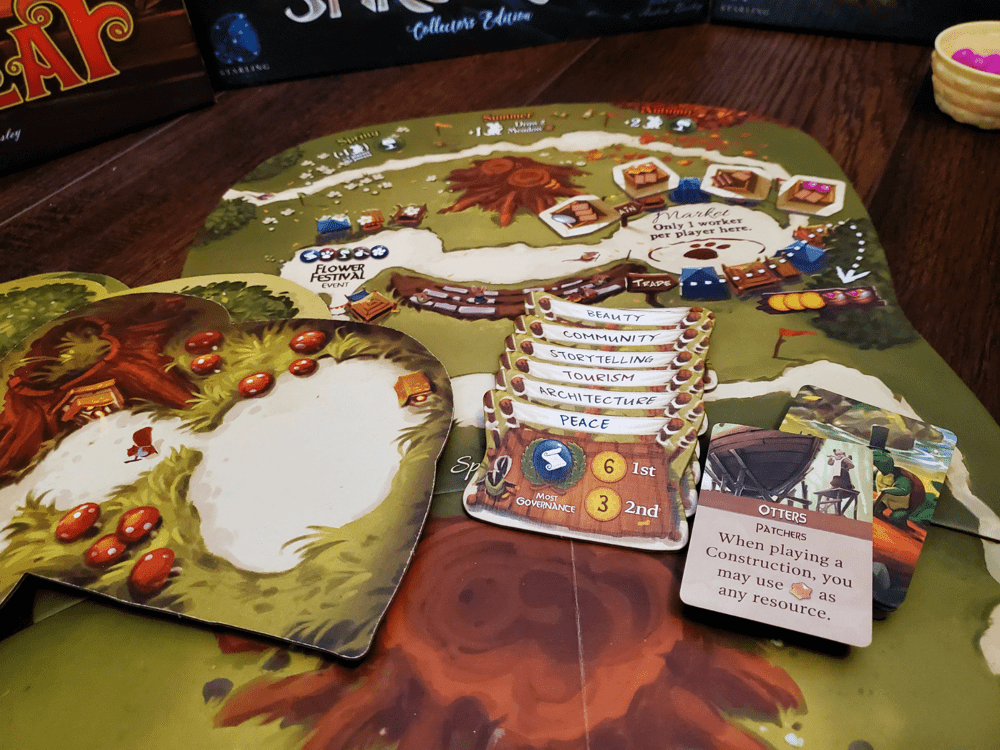
The player boards, while nice, didn’t provide that appeal either. These have never really caught on in our family. They are large and awkward, and they obscure the game materials that normally stand out so well just sitting on the table. And besides, we love freestyling the cities. Even when we take the boards out, I doubt we’re using them as intended. They’re just there to make our areas pretty.
Now the modules—we’ve stumbled upon another story altogether! We enjoy the Market, though we find we don’t utilize it all that often. The Garland Awards and the Flower Festival Event are fun and seamless boosts to the game. We don’t even pull out the northward-reaching Bellfaire board for these extras half the time, but that doesn’t make us love them any less!
Overall, Bellfaire doesn’t rank higher on the list because we are mixed on the contents. We’ve used it a fair amount in modular form—so much so that several pieces are better stored in the base box than the expansion. (Spoiler alert: I opted against the Big Box. I’ll address that decision at the end!) But there are others that better tune our heartstrings.
#6 – Pearlbrook
Pearlbrook was the first box expansion to see the light of retail day after the base game and Collector’s Edition. The western expansion introduced a new scene—the River. It also introduced the first oversized and specialized meeple—the Frog Ambassador, a specialized resource—the Pearl, and a game-changing substitution in the Wonders. River destinations instantly became a charming and lucrative source of resource swapping. Adornment cards introduced fascinating ways to spend the Pearls. The twenty new cards drew players into the new locations and options by earning and rewarding pearl collection.
I include the laundry list of changes because, in many ways, Pearlbrook created a new game altogether. Don’t get me wrong, I really enjoy this game. But when I’m looking for an expansion, I’m usually looking for one that is less jarring to my sensibilities. The River doesn’t qualify in that regard. Rather than a diverse world and city-building exercise, Pearlbrook feels like a race to build the Wonders. Less a bonus setting, the River eclipses the Meadow a bit too much to rank at the top of my list.

I can almost guarantee that everyone’s first play featured mildly neglected cities or cities engineered specifically to grab pearls to get the big Wonders, just to see if they pay off. I can still remember my daughter striving to build the EverTree—her favorite card—only to then trash it via the University or Ruins for a bonus and a chance at the twenty-five point Starfalls Flame. It was exciting, but why must the inclusion of a River eradicate celebrated Events and thrust play in one specific compass direction? The idea that a natural setting could upend the and eliminate key bits of creaturely life seemed odd then, and still does.
On the plus side, the Pirate Ship is a beautifully thematic card which—like Rugwort—lends a bit of a take-that mechanism. But because it can be sent back, it’s more of a give-and-take-that, so I find I don’t mind it as much. I enjoy that the corresponding Pirate matches the spirit of the Scurrble Stadium in presenting a gambling card draw. Mostly, though, the cards only widen the eclipse by pulling players to the River and away from the base game. While I don’t dislike the water world, I have to be in a different mood to play Pearlbrook because it is so very unique.
#5 – Spirecrest
After playing Pearlbrook, I was a little worried about Spirecrest. This massive expansion introduces beautiful new scenery, another oversized specialized meeple—the Rabbit Traveler, several tokens and cards, and, of course, the OVERsized (and wonderfully adorable) Big Critters. What separated Spirecrest from Pearlbrook and landed it higher on the list is the way the new mechanisms keep attention on the base experience.
With those Rabbits ambling the treacherous path, the Weather lets loose many unfortunate circumstances upon the Meadow. But the natural hindrances force a bit of creativity with the cards and twigs and whatnot. Spirecrest asks just how well you know the possibilities inherent in the deck and on the board. I can get behind such a change, especially as I’ve grown in experience.

The Discovery cards, on the other hand, ramp up the powers, dole out gigantic saddled meeples, and otherwise create moments of glee as players choose their imaginative blessings. There is a lovely balance in these two primary mechanisms, but most satisfying is they send all eyes back to the Meadow and the decisions that made Everdell great in the first place.
Likewise, the Expedition map tiles add a bit of the good stress by looking toward the endgame in anticipation of leftover cards, pebbles, resin, and the like. Building the path of a one-way journey adds an appropriate bit of intrigue.
Similar to Pearlbrook, I’d say the seams are extremely visible in the southerly Spirecrest. Every so often players look away from the base game board and experience and visit the Foothills, Peaks, and Ridge to the south. What keeps me coming back for more, though, is that you bring the mountaintop high back to the ground and get back to business from season to season.
#4 – Mistwood
I am not a solo gamer. In fairness to my love of Everdell, though, and in my desire to represent the full breadth of options well, I sat down to Mistwood and a mono e mono showdown (does Nightweave even have hands?!) with the spider. This expansion did not convert me. But there are two reasons I look at Mistwood so favorably on this list.
First, I recognize how important solo gaming can be within the hobby. I know the original Rugwort solo experience was viewed with mixed sentiments. Too punishing: I think that is the common phrase that accompanies the rat. With Nightweave, however, there is now a solo experience that feels more like the actual game with several twists.

The card mechanics are interesting and come with elevated depth via the Plots and Plans for those who prefer a more storied encounter. I appreciated the variety of actions on the cards, and I thought the progression of options was easy to follow and administer. There is a variable and viable opponent in Nightweave, and for that, I celebrate the solo offering. If nothing else, Mistwood might entice more players into the Everdell world. There are clearly laid out procedures to integrate every other expansion with the spider’s lair. Across the board, there seems to be a lot of love in this particular expansion.
But wait, there’s more! I am so very grateful for two additional perks that accompany the expansion, and they collectively form my second reason for placing Mistwood higher on the list. I suppose they could have been included anywhere, but they were in this box, which only served to secure the ranking. First, more Legends! I LOVE the Legends. My emotional spectrum experienced a thrill ride with this particular module. Second: the Through Every Season farm cards. With eight identical farms in the base game, I am smitten with the decision to diversify the farms so that they now both spark a tough decision and produce an I-knew-that-would-pay-off moment at the turn to Autumn.
What was one of my less anticipated boxes has certainly impressed me! And while I’m not ready to call the spiders a top 3 meeple, I was more than a little fired up when I saw them.
#3 – Newleaf
It was only a matter of time before a train rolled up to the Meadow. I would call Newleaf the largest “more of the same” expansion in the Everdell catalog. The Station allows for three more face-up cards, bringing the total to eleven—a massive help for the ever-growing deck, which takes on sixty more cards for the expansion. With the bump in opportunity comes a bump in funding as every action in the Station grants a bonus resource as well. The Visitors open the door to specific end-game bonus structures.
With so many new cards, Newleaf also includes the golden doors that grant a certain backdoor accessibility. This mechanic, which determines how Critters are claimed for “free” via a Construction, requires a bit of attention, but it bridges the gap well. The connections drawn are between card colors/types rather than specific names. Sometimes specifics are easier, and they are certainly more familiar to me at this point, but I think the gold is an ingenious solution to an otherwise very broad confusion.

I was worried the Visitors would turn into a late-game dumpster dive, but the mechanism is preventative. With a one-worker limit on the location at a given time, the stars must align to pull multiple cards in a given season. Plus, with all the work being done in the city, there isn’t always time to spend a worker gaining the card. Instead, they are a pleasant temptation and an occasional competition. Nicely done!
The Inbound/Outbound ticket module gives everyone a free Ranger or two in their back pocket. The Reserve token gives folks a chance to work towards a grand payoff by holding onto a card before its moment. Both modules work well and could easily transport to the base game with ease.
The two new Events make sense in that they round out the collection to include all of the most sensible options. Having two extra on the board increases the opportunity, temptation, and indecision over whether and when to secure the points.
The cards are much like the Events—they make sense. My favorites at this point include the adorable butterfly Poet who scours the Meadow so well, and the Greenhouse, which shares a space with the farm for some combo-tastic resource options. To be honest, just flipping through these cards made me fall in love with Newleaf and the ‘Dell all over again.
Newleaf comes in as the prize of the boxed expansions because it so capably amplifies the world of Everdell and all its charm. Mechanically, the eastern railroad doesn’t overwhelm with only two new spaces. Instead, it’s a series of open doors and, increasingly with the player count, better scoring opportunities.
#2 – Extra! Extra!
Another pack of only 15 cards, but therein lies the genius of Extra! Extra! Offered with the original Collector’s Edition, this set of circus acts gives the base game a little playful flair without turning anything upside down. Pushing the deck near 100 cards is no small matter, but they pair off easily enough and they add a bit of spice to the mix while introducing the world to Scurrble, the official sport of Everdell.
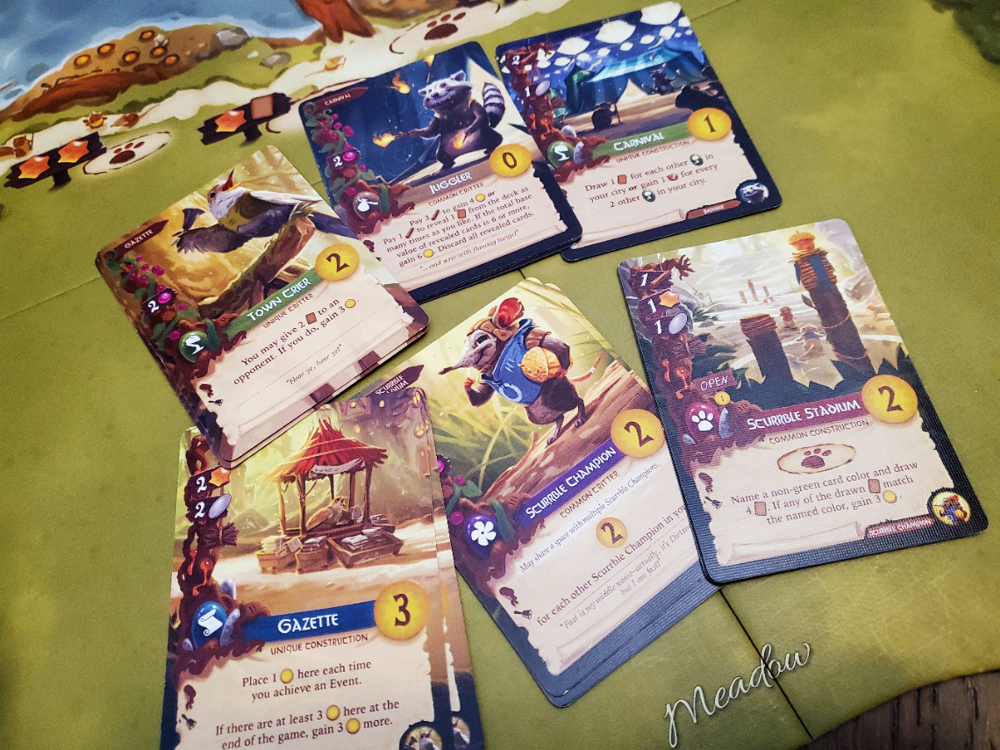
We’ve never once played without Extra! Extra! since it knocked on our door, not because the cards fix anything that was missing, but rather because they sing in perfect harmony with the whimsical tune of the wood. For my taste, I love the way the Gazette celebrates the big Events with gold. As for my daughter, she’ll be placing bets at the Scurrble Stadium til the cards wear thin. The personality and tone of these cards are a beautiful addition to the base.
There isn’t much more to say, and that is probably why it sits in the #2 spot. It just fits.
#1 – Legends
Without hesitation or doubt, Legends is my favorite expansion concept to grace the big board. Available from the first cards in the Collector’s Edition, this set has been further expanded by the occasional promo and in the Mistwood box to its full potential, and I honestly love every last bit.
Legends expands Everdell in all the best ways. Narratively, the cards introduce the celebrities, historical critters, and famous locales that dot the world’s history. There is a lore and a rich backstory to this wood, and these cards ooze that character. Mechanically, the Legendary places and persons merely bolster their more ordinary counterparts when played in the game, adding a shot of simple but effective adrenaline to the city. Expanding the city capacity from 15 to 17 is an understated design decision that allows for greatness but still leaves players wanting to try again.

This little pack, doled out two by two to each player in the game, opens a door to deeper strategic thought, deeper enjoyment of the world, slightly higher scoring, and a fuller appreciation of the creative endeavor that is Everdell. I cannot ask for more of an expansion. With supreme ease, it adds deserved grandeur to a game that already stands tall.
The Absurdity
In the name of science, I had no choice but to play one game with every available expansion (with the exception of Mistwood) simultaneously to see if Everdell can bear the weight of its own worldbuilding glory. I have to admit I was pleasantly surprised, though the absurd play did reinforce several of my opinions regarding the expansions.
The setup was no joke, obviously, but once laid out the game is quite stunning on the table. Assuming, that is, that a table of sufficient size is available. I’m not sure I’d have been half as happy playing on the floor! By game’s end, our dining room table might have been able to bear a third player, but even at two we were often standing for portions of our turn because the needed component was out of arm’s reach. The scores were bloated, but not to an extreme. Honestly, they were only a small percentage higher than my most recent play of Newleaf.
As expected, Pearlbrook asserted its dominant reach all over the board. The trouble with water is it gets into everything. We left the Events on the board, but there was never a moment where selecting one was more lucrative than pushing toward Pearlbrook’s Wonders or one of Newleaf’s Visitors. In the end, the difference in the score was almost equal to the difference between the Wonders my daughter and I had chased.

Spirecrest proved its worth admirably. The Big Critters were a massive help in the wider affair, and the Weather effects forced the same sort of strategic adjustments along the way. We were still able to pull off most of our Expedition targets. For what it’s worth, the new saddles (if any out there know the frustration of the first edition’s troubles) work beautifully—we were so happy to finally mount up the critters properly.
Bellfaire faded understandably into the background. We each visited the Market enough to collect the first run of resources, but it was hardly worthwhile in the grand scheme except as a way to bypass the grip of Spirecrest’s shackles on the Meadow and resources. The Garland Award was, pleasantly, another key factor in the final score.
Various cards didn’t take up space in our cities, which opened the door to my daughter’s city containing 22 cards (thank you Corrin Evertail!) and mine having 20 thanks to a Farm/Greenhouse combo that was outside the city, a Legend/Harvester combo, and others.
My daughter even passed me her Rugwort cards as part of a card effect. It was a sweet gesture, because she knew I would just discard him at the first opportunity in favor of resources, points, or anything else.
Fear not the absurdly overexpanded play. I doubt I’ll try it again soon, but it was interesting!
Settled
So what does Everdell look like for me when it comes off the shelf? As I said earlier, I decided to forego the Big Box. I’ve had a chance to peruse the contents and layouts and I stand by my decision for one reason: At most, I only need one box expansion at a time. Truth be told, I’m too lazy to haul twenty pounds of content to someone’s house—or even my own table—when I don’t need half the materials inside. I wish there had been an option, since all of the expansions are nearly the same thickness, for a reasonable box for the base game that left a couple inches at the top to slip an expansion insert inside. Talk about ideal! But alas, I’m picky. I know this.
I keep the base game box loaded with all of the unstickered meeples. I keep the base deck shuffled with Extra! Extra! and, yes, Rugwort. The Legends are in the box as well. I’ve removed the old Farms in favor of the Farms through the seasons.
I’ve removed the Husbands and Wives in favor of the Wilson family cards. I’ve not spoken of the Everdell for Everyone pack to this point, but the shift from Husbands/Wives to Harvesters/Gatherers is complete, with every card now bearing the new wording. I’m not the sort that necessarily wants to see myself or my handwriting in a (non-legacy) game, so the custom cards are not that appealing to me. When I saw the Wilson family option, I was unexpectedly enamored with the idea. As this is their creation, and one that has meant a lot to me, I’m happy to honor them by using their names and images. The fact that the family cards have names contributes a narrative voice to the game! Of course, it’s all about preference.
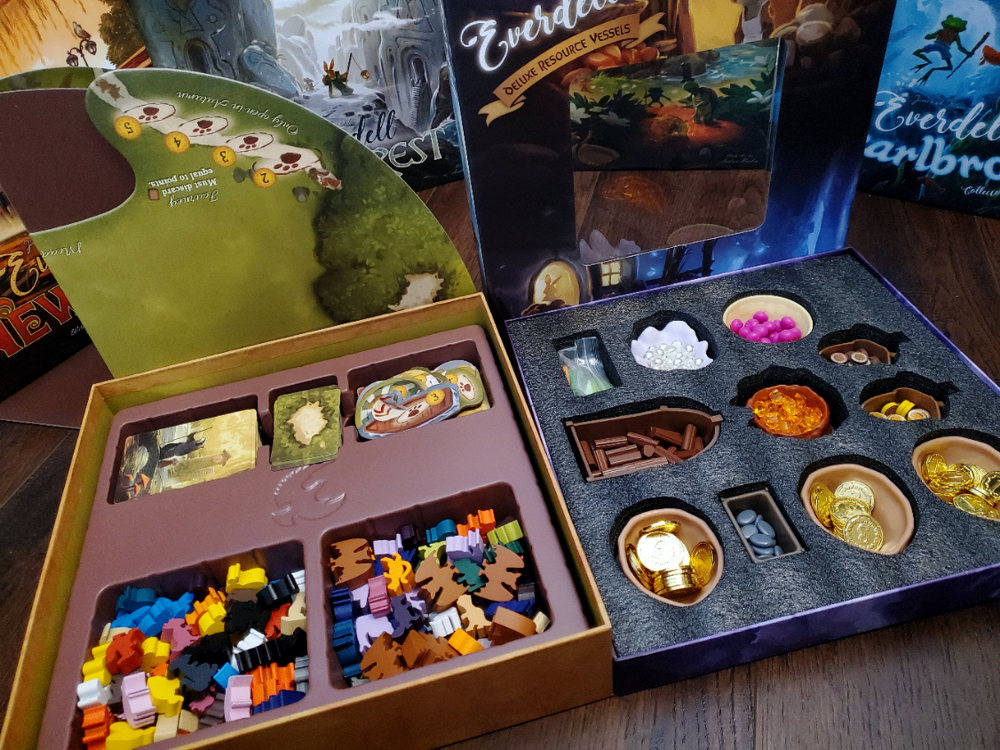
I keep the resources and coins in the Deluxe vessel box, fully loaded and ready to play. As long as I don’t turn that one upside down, it’s a perfect solution that affords me the space to load the base game insert with my favorite modular bits. I keep the EverTree tucked away on a bookshelf. If we’re in a mood we’ll bust it out, but we’re mostly happy without it.
The only component in the entire series that I’ll replace (via Etsy, no doubt) is the set of “Open” signs that came with Pearlbrook. They are a bit oversized and unwieldy, and they don’t fit in the base box. I’m going for “just large enough to notice.” Something the size of the meeples will do. Otherwise, I keep the expansion-specific materials and the less common modules in their boxes for the time that we’re itching to bring them to the table.
I still think plain old Everdell is a 10/10—with cardboard chits, the base cards, and the squishy berries. I’d be just as happy today to play the original retail edition. It’s enough. I’m also quite thrilled that the worthwhile content doesn’t stop there. I’m most happy, though, when I only grab what I’ve mixed into the base box (and now the resource box to go with) and visit my favorite setting in tabletop gaming.










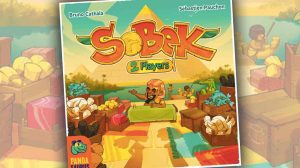






Thanks for the write up! I haven’t played the last four expansions yet, but am happy to have all of them now. I also passed on the big box for the same reasons. I decided to put base Everdell CE, Bellfaire, Mistwood, Legends, Rugwort, Extra Extra, the small promos, and all the meeples/meeple powers together in the base game box (obviously without the insert), since these options can be played with any expansions (I think so, anyway). I also have the boards from those expansions, and Gilded book/Archive in there, but it is a very tight squeeze. My hope is that this set up will work, and then we can grab whatever big box expansion we want to play with off the shelf separately. I will have to see how it works in action..hoping to test out all of the new stuff in the coming months! We had plenty of fun with just the base game and Pearlbrook, but I am looking forward to more Everdell.
Thanks for the comment! I’ve managed to hang on to the base game insert, but it sounds like you have a solid setup inside. You even managed to squeeze in the gilded book!! Once you get the various expansions to the table, I’d love to know how my rankings compare and if you find that beautiful base box is just right for most occasions!
Hey there,
Thanks for this amazing write up!
I just ordered pack 2nd hand which adds Bellfaire / Pearbrook / Spirecrest to the collection.
I don’t know if I’m going to keep all 3, Spirecrest and Newleaf are really high up on my wish list and especially after this read through.
In the Mistwood section, you talk about new legends, which are those?
Also, the mistwood expansion adds a co-op option right?
Thanks in advance and keep up the good work!
What a wonderful read- informative AND fun. Thank you! I think we’ll start with Extra! Extra! and move on to Legends if it feels good. I can barely convince the family to play the base game with me (they have deemed it “FOReverdell”) so I best not get too big too soon! Off to look for your other reviews- wonder what your second favourite is (Wingspan tops our list).
What a nice thing to say Jen, thanks for taking the time to reply!
Hello Jen! My apologies for missing this generous remark! I would love to hear what you think of your expansion endeavors and whether the family comes around. I am thankful that there are folks around who love this little world. Personally, my second favorite is Obsession (speaking of long experiences), followed by Warsaw: City of Ruins and maybe Petrichor? They all tread different thematic grounds, but I love the interaction of setting and mechanism for each!
A great review of a great game! Thanks for the entertaining read!
Thank you for the kind word! No title has come close to knocking Everdell from the top of my list. No one ever has to twist my arm to pen a few words. Happy gaming!